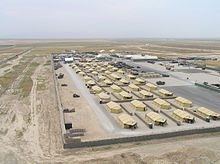Hesco bastion


The Concertainer,[1] known colloquially as the HESCO MIL,[2] Hesco barrier,[3] or Hesco bastion,[4] is a modern gabion primarily used for flood control and military fortifications.[5] It is made of a collapsible wire mesh container and heavy duty fabric liner, and used as a temporary to semi-permanent levee or blast wall against small-arms fire and/or explosives. It has seen considerable use during the wars in Iraq and Afghanistan.
Originally designed for use on beaches and marshes for erosion and flood control,[6] the HESCO barrier quickly became a popular security device in the 1990s.[7] HESCO barriers continue to be used for their original purpose. They were used in 2005 to reinforce levees around New Orleans in the weeks between Hurricane Katrina and Hurricane Rita.[8] During the June 2008 Midwest floods 8,200 m (9,000 yd) of HESCO barrier wall were shipped to Iowa.[9] In late March 2009, 10,700 m (11,700 yd) of HESCO barrier were delivered to Fargo, North Dakota to protect against floods. In late September 2016, 16 km (10 mi) of HESCO barriers were used in Cedar Rapids, Iowa, for the fall flood of 2016.[10]
Development[]
The Concertainer was originally developed by Jimi Heselden, a British entrepreneur and ex-coal miner, who founded HESCO Bastion Ltd. in 1989 to manufacture his invention.[11] The brand name for the barrier is a portmanteau of the words "concertina" and "container".[1]
Assembly[]
Assembling the HESCO MIL units entails unfolding it and filling it with sand, soil or gravel, usually using a front end loader. The placement of the barrier is generally very similar to the placement of a sandbag barrier or earth berm except that room must generally be allowed for the equipment used to fill the barrier. The main advantage of HESCO barriers, strongly contributing to their popularity with troops and flood fighters, is the quick and easy setup. Previously, people had to fill sandbags, a slow undertaking, with one worker filling about 20 sandbags per hour. Workers using HESCO barriers and a front end loader can do ten times the work of those using sandbags.[12]
The HESCO barriers come in a variety of sizes. Most of the barriers can also be stacked, and they are shipped collapsed in compact sets. Example dimensions of typical configurations are 1.4 m × 1.1 m × 9.8 m (4.6 ft × 3.6 ft × 32.2 ft) to 2.1 m × 1.5 m × 30 m (6.9 ft × 4.9 ft × 98.4 ft).
A new system of HESCO MIL Concertainer developed specially for military use is deployed from a container, which is dragged along the line of ground where the barrier is to be formed, unfolding up to several hundred metres of barrier ready for filling within minutes.[13]

United States Navy SEABEES assembling HESCO MIL units.
Iraqi Army engineers fill a section of four-foot HESCO MIL with a bucket loader.
See also[]
- Bremer wall - steel-reinforced concrete blast walls
References[]
- ^ a b Heselden, J.W. (November 1997). "Reinforcement and Control Using Concertainers". In C.V.J. Varma (ed.). Geosynthetics Asia 1997: Select papers. Geosynthetics Asia 1997. G. Venkatappa Rao; A.R.G. Rao. Bangalore, India: CRC Press. p. 496. ISBN 9789054107705. Retrieved 2012-08-27.
The name 'Concertainer', which is a registered trade mark, refers to the unique way that units fold flat concertina style. This ensures very efficient packaging, handling, and erection.
- ^ "HESCO". Army Technology. Archived from the original on April 10, 2020. Retrieved 2020-05-19.
- ^ "What are the 'HESCO' barriers used to shore up the LA River?". Southern California Public Radio. January 11, 2016. Archived from the original on September 20, 2017. Retrieved 2020-05-19.
- ^ "Watch the moment WW2 bomb is blown up". Kent Online. May 14, 2020. Archived from the original on May 19, 2020. Retrieved 2020-05-19.
- ^ "Ex-miner's £10m gift to good causes". Yorkshire Evening Post. 25 March 2008. Archived from the original on November 16, 2016. Retrieved 2020-05-19.CS1 maint: unfit URL (link)
- ^ Flood Fighting Structures Demonstration and Evaluation Program Archived 2006-06-22 at the Wayback Machine U.S. Army Corps of Engineers, Engineer Research and Development Center, Factsheet January 2006
- ^ Engineers wall Dobol Archived 2009-03-06 at the Wayback Machine The Talon, Operation Joint Endeavour, Friday 6 December 1996
- ^ "HESCO Bastion - A simple approach to flood protection and much more", Progressive Engineer, 2006, archived from the original on 2008-12-01
- ^ Hammond company helps Midwest hold back flood - David, David; Hammond Daily Star, June 25, 2008
- ^ Cedar Rapids Discusses Permanent Flood Protection - Kalk, Jordee; KCRG, September 26, 2016
- ^ "Owner of Segway Company Dies in Segway Accident" New York Times, September 27, 2010
- ^ Mike Nowatzki, Flood Update: Portable floodwalls will be used in flood fight as city scrambles for protection The Fargo-Moorhead INFORUM March 23, 2009.
- ^ HESCO Raid (from the manufacturer Web site)
External links[]
| Wikimedia Commons has media related to HESCO bastions. |
- HESCO Bastion Ltd—HESCO company site
- British inventions
- Flood barriers
- Fortification (architectural elements)
- Gabions

